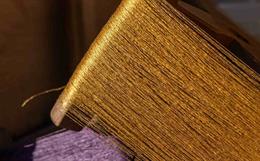Introduction:
Todays requirement is no longer about spinning, weaving orknitting, but rather about flexible material engineering. Yarn and fabricproducers and finishers too must be extremely well informed about the materialsto be processed. It is essential to know how these materials will perform inthe sun, wind and rain.
Woven sportswear fabrics are also used for protection against wind and weather and also for insulation purposes. Woven fabrics for protection against the weather were previously coated with polyvinyl alcohol andpolyvinylchloride in most cases. Polyvinylchloride coating guarantees absolutewaterproofness, but has a serious disadvantage. It allows no passage of air;the wearer perspires only after a few minutes and has no opportunity of givingoff body moisture to the outside. Today, there is a wealth of alternativecoatings and methods to replace PVC, like micro porous fluorocarbon coatingperhaps, which provide some breathing activity to the fabric.
Thermal Protection:
Thermal insulation (Protection from cold): New developments:
One new advancement in fiber technology involves theinvention of a unique, patented thermal insulation of fine bonded polyestercalled Primaloft, manufactured by Albany International. It is used for insulatingsuch things as sleeping bags and snow skiing clothes because it is lightweight, durable and maintains its insulating properties when wet.
Thermal clothing giant Damart has launched a new sportsrange employing the fabric it claims as the warmest in the world. The fabricsdevelop a Thermolactyl charge between the skin and the garment. This creates apositive static charge that helps trap a layer of air insulating the body.
Eschler which promotes ideal moisture transport provides a fabric for thermal insulation. The protective layer with water repelling and windblocking properties that can nevertheless still transport moisture from theinside to the outside is worn over both of these layers. Schoeller Textil AGhas developed a WB-formula for weather protection membrane (a stretch weave)for jackets.
Soft shells are high breathing light durable, waterrepelling and wind proof stretch fabrics from Schoeller.
Thermally sensitive materials
An ideal clothing fabric, in terms of thermal comfort, shouldhave the following attributes: (1) high thermal resistance for protection from the cold, (2) low water vapor resistance for efficient heat transfer under amild thermal stress conditions and; (3) rapid liquid transport characteristicsfor transferring heat efficiently and eliminating unpleasant tactile sensationsdue to perspiration under high thermal stress conditions.
Extremely cold weather protective clothing refers togarments that are used in extreme climates such as on the Trans-Antarticaexpeditions, in skiwear, mountaineering and for army personnel posted in hillyareas at high altitudes. For this purpose, clothing that provides a high degreeof insulation with the least amount of bulk is most desirable.
Thermal storage and thermal insulating materials:
Zirconium magnesium oxide or iron oxide can be used asparticulate filters in the molten polymer for producing heat generatingpolyester, polyamide, polyethylene, polypropylene and other functional fibres.By applying the heat insulation principle, heat-regenerating fibres fromceramic composites utilize the far infra-red radiation effect of ceramiccomposites, which heat the substrate homogenously by activating molecularmotion.
Thermo-regulated textiles:
To keep the skin temperature within the 30.4 to 36.40 interval, we must put on or take off our clothing according to the external temperature. If clothing could automatically change its thermal resistance according to the temperature, it could control the speed of heat release, and then regulate the inner temperature. There are three types of heat storage: sensible latent and chemical reaction heat storage. Latent heat storage is the most important way of storing heat, and is also called phase change heat storage. NASA accelerated the application research of latent heat-storage materials for the space laboratory in the 1960s. They were used to improve the protection of instruments and astronauts against extreme fluctuations in temperature in space. Latent heat-storage materials were used in the lunar vehicle and the Sky lab project for the Apollo 15 mission in the 1980s.
Wind Protection:
Not just micro fibres, but many other important developments were initiated long ago. One of the earliest pioneers was the trademark NINO FLEX, established early in the 1950s, in Germany. Using that label to identify a premium class of poplin, the owners started a great advertisement campaign. In cooperation with garment manufacturers and retailers they drew consumers attention to the great importance of certain selected fabric properties, for example water repellant and windproof. These two properties might have expected to have received a positive response, since weather protection was the main task of the trench coat, anorak, duffle coat and parka.
However, the new coinage atmungsativ created a great surprise. It means self ventilating and underlined the fact that the fabric would not hinder the wearers body from breathing, as rubber coats usually did. Clothing physiologists at first offered the criticism that first a fabric itself cannot breathe. But the new idea was obviously very catchy, so it rapidly became famous. That adjective quickly convinced consumers about wear comfort and its preconditions. Previously, such aspects had been almost ignored. But now, they achieved the same importance as a fashionable fabric design or up-to-date styling. Consumers new consciousness of wear comfort and its physiological context, initiated by this progressive type of advertising, pointed the way ahead. It had formative influence on all further textile developments. For a short time, a rapidly increasing motorization reduced the importance of windproof and water-repellant treatments, inside a car, weather protective clothing was not necessary. But that changed, when sports and leisure activities began to occupy people more and more. Now, whenever possible, fabrics should be waterproof and self ventilating.1
With the presentation of Wind stopper Soft Shell fabrics at the Techtextil WL Gore & Associates showed the first soft shells that provide reliable, comfortable protection from wind and weather. Like all other Wind stopper products, Wind stopper Soft Shell garments effectively protect the user from biting wind-chills while offering excellent breathability. In addition, these new functional fabrics offer excellent abrasion resistance as well as reliable snow shedding and water resistance benefits all in a single lightweight garment. Wind stopper Soft Shell garments are multitalented, simplified garment systems where one layer can provide the function of the two.
The secret behind the three layer Wind stopper Soft Shell fabrics is the extraordinary versatility of the Gores textile technology. It is this technology that makes it possible to use the Wind stopper membrane in combination with abrasion resistant face fabrics, which have been treated with water repellant finish and warm softer inner linings. Wind stopper Soft Shell garment can also be manufactured in stretch fabrics.
This has considerably broadened the spectrum of uses of Wind stopper membrane in combination with abrasion resistant face fabrics, which have been treated with water repellant finish, and warm soft inner linings. Wind stopper Soft Shell garment can also be manufactured in stretch fabrics
This has considerably broadened the spectrum of uses of Wind stopper functional fabrics: garments made with breathable Wind stopper Soft Shell fabrics can just as well be worn when doing the kinds of jobs that make one sweat from exertion as when taking a break even in light rain or snowfall.2
Carrington has also recently formed an alliance with Sympatex, which manufacturers the All Weather range a highly effective and versatile weatherproofing system that allows for warm and comfortable apparel that is 100% waterproof, 100% windproof and breathable.
The Professional range from Sympatex offers the optimum balance of protection and comfort in active and extreme situations where performance is required. Available in 2 and 3 layer options these fabrics have been tested and approved based upon criteria of extreme durability, optimum breathability and the highest levels of wearer comfort. Independent tests at the renowned Hohenstein Research Institute have shown Sympatex Professional laminates able to withstand 100 metres of Hydrostatic Head (water pressure). Clothing with All Weather can be washed and dry-cleaned and will not impair the waterproof, windproof and breathable properties.
In another of the companys latest developments, the membrane system in the Sympatex High2Out range means that liquid perspiration does not bleed onto the lining but is absorbed and spread out over a larger surface area. Moisture can evaporate quickly to the outside spreading the moisture over a larger area.
Many of the modern synthetic fibres have properties that make them superior to natural fibres when it comes to sport they are lighter, more robust, denser and easier to care for. Their intelligent designs impart clothing with capabilities they have never before had protecting the skin from every possible influence, whether cold, heat, weather and wind. When it comes to clothing for the outdoors, the three layer model has been the defining standard for many years. The inner layer, the functional underwear which is worn directly next to the skin, is responsible for moisture transport. One of the processed fabrics available from underwear manufacturers is Atmos from Eschler; which promotes ideal moisture transport from inside to outside. The middle layer, a fleece like Husky from Eschler which has enjoyed world wide popularity for many years, provides thermal insulation. The protective layer, a jacket with water-repelling and wind-blocking properties that can nevertheless still transport moisture from the inside to the outside, is worn over both of these layers. Schoeller Textile AG has developed the WB-formula weather protection membrane (a stretch weave) for jackets. The Pendant by Eschler is knit based and named Estar 2000.
Gore Windstopper
The specially engineered Gore Windstopper membrane provides wind protection and stabilises the microclimate close to the skin by allowing excess
moisture to escape while preventing unwanted moisture from coming back in. GORE-TEX fabric was the
first highly durable and windproof, waterproof/breathable fabric to be
introduced to outdoor enthusiasts. Since 1976, continuous improvements have been made to GORE-TEX fabrics to meet an ever-increasing demand for highly
functional and specialized fabrics. GORE-TEX fabric is recognized as the most
durable waterproof/breathable fabric available.
The bicomponent GORE-TEX membrane consists of a composite of two unique
materials with exceptional mechanical and chemical stability. The expanded PTFE
(ePTFE) portion of the membrane contains over 1.4 billion microscopic pores per
square cm. These pores are much smaller than a droplet of liquid water, but
much larger than a vapour molecule. Water in its liquid form cannot penetrate
the GORE-TEX membrane, but as moisture vapour (a gas), it can pass through
easily. At about the
same time huge advances in breathable fabrics were being made. Gore Tex was the original product used to make breathable, but water resistant windproof outer garments. Gore-Tex is not a fabric, but a membrane which is laminated to other
fabrics such as polyester or nylon to suit a manufacturer's end use for
breathable clothing.
Like all WINDSTOPPER fabrics, WINDSTOPPER Soft Shells protect the user from biting wind-chill while allowing moisture vapor to easily escape during rigorous activity. In addition, WINDSTOPPER Soft Shells offer excellent abrasion resistance, snow shedding, water resistance, and stretch benefits, all in a single lightweight garment, allowing outdoor enthusiasts to effectively combine their insulating layer and shell in the widest range of activities and weather conditions without sacrificing performance.
WINDSTOPPER Soft Shells water resistance and snow shedding capability is due to a unique combination of durable water repellency (DWR) and membrane technology. Other soft shell products rely heavily on water repellency to resist water penetration, but offer little protection once the repellent treatment wears off. Gores research indicates that at low water-entry pressures (less than 1.5 psi or pressure slightly more than heavy rain), other products allow over a half liter per minute of water to penetrate, while the WINDSTOPPER Soft Shell material completely and durably resists penetration, thanks to its high-performance membrane technology.
WINDSTOPPER Soft Shells, which offer a unique combination of total wind protection, excellent breathability, and garment ventilation, enable the user to seal out the weather or promote rapid heat loss, increasing the comfort range while reducing the need to wear and carry more garments. WINDSTOPPER Soft Shells enable outdoor enthusiasts to dial in their comfort without the need to change layers in the middle of the trail. The WINDSTOPPER membrane does not affect the breathability of the base textiles, resulting in excellent moisture transfer regardless of the wind. This excellent breathability makes WINDSTOPPER Soft Shells very versatile they can be worn as a stand-alone shell or layered under a GORE-TEX shell when the weather gets extreme.
Other fibres like Activent a breathable fabric from Gore, and Ecolite with its ecological breathable coating and Tactel a lightweight nylon which can have an applied waterproof breathable coating, all perform in a similar way. Throughout the 1980s, Gore Tex was used primarily in skiwear, golfing and expedition wear.
Integrated into the ePTFE structure is an oleophobic, or oil-hating, substance which allows moisture vapour to pass through, but is a physical barrier that prevents the penetration of contaminating substances such as oils, cosmetics, insect repellents and food substances, which could otherwise affect waterproof performance. Because the oleophobic substance is totally air-impermeable, the bicomponent membrane is totally windproof.
Polartec Windbloc
Soft and comfortable fabric made from 2 layers of velour fleece laminated either side of a windproof and breathable PU membrane. DWR outer sheds light rain and snow whilst a wicking treatment on the inner boosts breathability.
Polartec textile:
- Polartec Powershield Stretch: veritable armour which blocks 95% of
wind. A veritable shield, which is extremely resistant to abrasion and prevents the lengthening of small rips, but is also resistant to rain and snow.
- Polartec Thermal Pro : The state-of-the-art
for lightweight warmth, breathability, and water repellency.
Extremely durable and dries quickly. Thermal Pro Fabrics keep you warm and
comfortable in a wide range of conditions.
- Polartec Windpro Stretch : Made for action, it combines two-way elasticity next to the skin with maximum wind protection. Fleecy inner surface for guaranteed insulating power.
Windwall
Windwall fabric is a proprietary wind-resistant fleece from The North Face. Through a fabric bonding process, Windwall fabric allows a limited degree of air permeability, resulting in increased breathability and comfort. Windwall 1 fabric has a mesh liner and Windwall 2 fabric has a grid fleece liner.
Environmental protective clothing for defence applications:
Military forces have to be prepared to operate in all parts of the globe from arctic, through temperate, to jungle and desert areas. As such they experience a wide range of climatic conditions possible, encountering rain, snow, fog, wind, lightning, sunlight and dust. The army requires different uniforms for use in five basic climates: hot-wet, hot-dry and temperature, cold-wet and cold-dry. In hot-wet, hot-dry and temperature environments battle-dress uniforms are worn that are made from a blend of 50% cotton, 49% high tenacity nylon, and 1% static dissipitative fibre. The balance of durability and comfort are critical performance factors. The temperate battle uniforms is made from a 7 ounce per square yard twill fabric. The hot weather and desert battle-dress uniforms are made from a 6 ounce per square yard ripstop poplin fabric.
Protection from extreme cold weather is another aspect of military clothing. The U.S. Army Natick Research, Development and Engineering Center developed the Extended Cold Weather Clothing System (ECWCS) for this purpose. It is made from synthetic fibres which transport the moisture vapour permeability, consists of polypropylene under wear, cold weather trousers, field jacket and trouser made with a semi-permeable film laminated fabric. This system performs well at -250F. By adding a polyester fibre pile shirt and bib overalls, the range can be extended to -600F.
Altough fabrics treated with water repellant finishes can withstand light showers, they are not water proof. Woven cotton and nylon blend fabrics with a fluoro-carbon based water and oil repellant finish.
High performance textiles:
In new developments in heat retention and exothermic functions for sports wear and leisure wear, passive heat retention is achieved by numerous pores in the textile product interior by means of bulked and microfibre constructions which absorbs sunlight and ultra-violet rays.
In conjunction with Toyobo Co, Mizuno Corp is marketing the Breath-thermo product, which consists of a polyester fibre cross-linked with polyacrylics. The material has therefore an effective water absorption capacity and exothermic characteristics which occur due to molecular friction of the water. The temperature in the textile interior can consequently be 2 to 30 C.
Descente and Adidas, Japan have used a fibreExlive fibre, which contains acrylate powder with a grain size of 0.2 m. This material has a higher water absorption capacity than silica gel and offers important exothermic characteristics due to its water absorption capacity.
The Warmsensor woven fabric types containing special ceramics developed at Toray Industries form the basic material for a three layer construction with absorptive, insulating and heat repellant layers, the effective heat retaining capacity of which is 2 to 30 C higher than with other conventional textile products. Polartech, clothing with an integral lithium battery was presented by Malden Mills ISPO 2000 for the first time. The thin heater plate can produce heat for five hours, keeping the garment warm.
During the 1998 Winter OLYMPICS, press representatives wore the Descent Mobile Thermo snow jacket with an integral heating system inside the garment which guaranteed precise temperature control in the interior. The thermocatch heat insulation developed by Mitsubishi Rayon with acrylic fibres contains in the fibre core fine ceramic particles which convert light into heat and with an antimony/stannic oxide component in the sheath core.
Summary:
New applications and developments are becoming a necessity. Scope for such garments is on an increase.
References:
- Felix F.Robers, Intelligent Textiles, July-Aug 2003, p 11-14.
- Anon, Techtextil Positive impulses, Asian Textile Journal, June 2003, p 53.
- Hadyn Davis, Protection is paramount, Textile Month, Jan 2003, p 14 19.
- Xiaoming Tao, Smart fibres, fabrics and clothing, The Textile Institute, Woodhead Publishing Ltd., p 58 70.
- H.Meinander, Cold Protective Clothing, Niches in the world of textiles, The 77th World Conference of the Textile Institute, p 190.
- H.Anttonen, Risks of cold work and properties of cold protective clothing, Niches in the world of textiles, The 77th World Conference of The Textile Institute, p 195.
- Prof. Dr. Joachim Hilden, Health and safety at work thanks to textile products, International Textile Bulletin, 2/2002, p 103-105.
- Sabit Adanur, Wellington Sears Handbook of Industrial Textiles, Military and Defence Textiles, p 359-.
- Daniel Paul Sinden, Studies on the properties of responsive heat barrier materials, AATCC Conference, p 51.
- Jurg Rupp, High Performance textiles or smart textiles? Theres money in know how, International Textile Bulletin, 3/2001, p 6-24.
About the Author:
The author is Selection Grade Lecturer in Textile Technology Department at Sarvajanik College of Engineering & Technology, Surat.
To read more articles on Textile, Industry, Technical Textile, Dyes & Chemicals, Machinery, Fashion, Apparel, Technology, Retail, Leather, Footwear & Jewellery, Software and General please visit http://articles.fibre2fashion.com
To promote your company, product and services via promotional article, follow
this link: http://www.fibre2fashion.com/services/article-writing-service/content-promotion-services.asp







